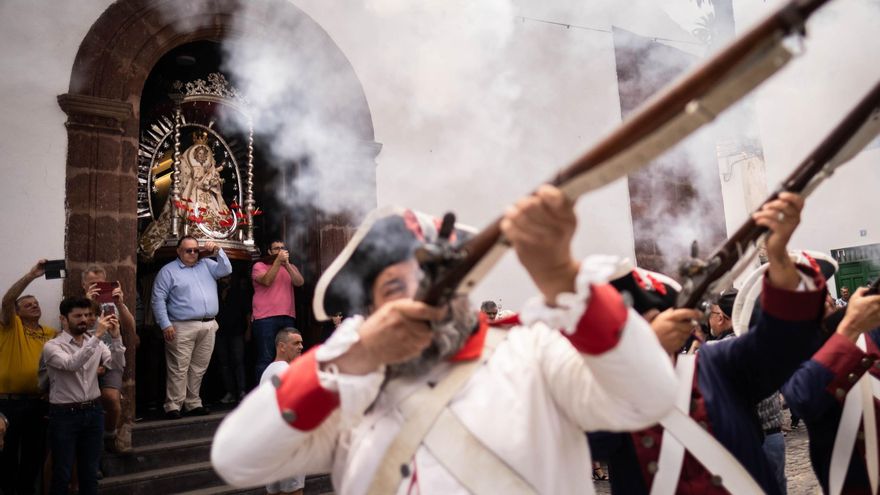
Battle between ships and castles with soldiers dressed in period clothing during the patron saint festivities. It is the usual scenery of the liveries of the north of Tenerife that are rooted in the tradition of popular militias. The Cultural Center of El Portezuelo (Tegueste) hosted the constitution of the Cultural Federation Liveries of Tenerife, collective that unifies the five traditional events that are celebrated on the Island, those of Taganana, Valle de Guerra, Tegueste, Icod de los Vinos and Buenavista del Norte. The Federation is made up of the associations Cultural Amigos de La Librea, Cultural Librea de los Diablos de las Angustias, Vecinos La Voz del Valle de Taganana, Cultural de las Libreas de El Palmar and the Folklore Group of the Faculty of Education of the University of La Laguna (ULL). Its main purpose is to promote general interest through the organization, development and celebration of activities to cultivate and promote traditional Canarian culture. It is worth highlighting the organization of the Insular Livery Meeting, as well as the work in research, recovery and promotion of this tradition on the Island.
Taganana
The Taganana Livery commemorates the fourth militia of Tenerife, which defended the Island in 1797 from the attack of the English troops led by Horacio Nelson. The militias were made up of non-professional citizens of arms who momentarily abandoned their jobs to repel from their population the attacks of pirates, privateers and foreign troops.
Valley of War
The Valle de Guerra Livery is one of the main events of the festivities in honor of the Virgen del Rosario. It is celebrated every year on the Saturday closest to the day it commemorates, October 7. It consists of two acts: the parade of the ships that guard the Virgin to the church square, and the naval battle of Lepanto, which took place in 1571 between a fleet of the Turkish Empire and another of the Holy League.
Tegueste
Asset of Cultural Interest (BIC), the Tegueste Livery dates back to the 17th century, it is celebrated every four years at the beginning of September as the big day of the Los Remedios festivities. It has its origin in gratitude to the patron saints for freeing the town from the plague or pirate attacks. Neighbors dressed in traditional costumes represent scenes of rural life and their religious customs. While soldiers march through the streets of the town towards the captain’s house, suddenly, a battle begins between the ships and the castle.
Icod of the Wines
The Livery of the Devils, in the municipality of Icod de los Vinos, is an ancient and original tradition in which the devil and the she-devil dance to the sound of the tajaraste to scare children until the Virgin of Las Angustias intervenes.
Buenavista del Norte
The Palmar Livery coincides with the festival of the Virgin of Consolation. During the dance, which runs through the streets of the town, three male couples of dancers, half of them dressed as women, dance to the sound of the tajaraste. The dancers are accompanied by the figures of the devil and the devil, symbolizing good as opposed to evil. This dance, whose origin was to scare away the evils of the crops, ends by setting fire to the fuse that the devils carry behind their backs. As for the Livery of El Lugar, it stopped being celebrated prior to the outbreak of the Civil War. It had to do with the death of the elderly people who promoted it and the war conflict also influenced it. The objective is the same as in the Librea del Palmar, but there are notable formal differences between the two. In El Palmar, the devil is loose; In Buenavista (El Lugar), a girl dressed as an angel wears it on a chain. In the latter three men and three women dance.















